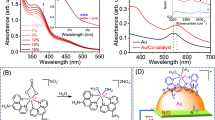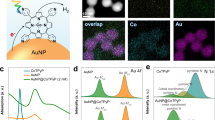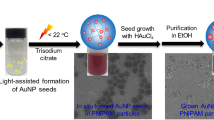Abstract
It has been shown that photoexcitation of plasmonic metal nanoparticles (Ag, Au and Cu) can induce direct photochemical reactions. However, the widespread application of this technology in catalysis has been limited by the relatively poor chemical reactivity of noble metal surfaces. Despite efforts to combine plasmonic and catalytic metals, the physical mechanisms that govern energy transfer from plasmonic metals to catalytic metals remain unclear. Here we show that hybrid core–shell nanostructures in which a core plasmonic metal harvests visible-light photons can selectively channel that energy into catalytically active centres on the nanostructure shell. To accomplish this, we developed a synthetic protocol to deposit a few monolayers of Pt onto Ag nanocubes. This model system allows us to conclusively separate the optical and catalytic functions of the hybrid nanomaterial and determine that the flow of energy is strongly biased towards the excitation of energetic charge carriers in the Pt shell. We demonstrate the utility of these nanostructures for photocatalytic chemical reactions in the preferential oxidation of CO in excess H2. Our data demonstrate that the reaction occurs exclusively on the Pt surface.
This is a preview of subscription content, access via your institution
Access options
Access Nature and 54 other Nature Portfolio journals
Get Nature+, our best-value online-access subscription
$29.99 / 30 days
cancel any time
Subscribe to this journal
Receive 12 print issues and online access
$259.00 per year
only $21.58 per issue
Buy this article
- Purchase on Springer Link
- Instant access to full article PDF
Prices may be subject to local taxes which are calculated during checkout



Similar content being viewed by others
References
Christopher, P., Xin, H. & Linic, S. Visible-light-enhanced catalytic oxidation reactions on plasmonic silver nanostructures. Nat. Chem. 3, 467–472 (2011).
Mukherjee, S. et al. Hot electrons do the impossible: plasmon-induced dissociation of H2 on Au. Nano Lett. 13, 240–247 (2013).
Xiao, Q. et al. Alloying gold with copper makes for a highly selective visible-light photocatalyst for the reduction of nitroaromatics to anilines. ACS Catal. 6, 1744–1753 (2016).
Kale, M. J., Avanesian, T. & Christopher, P. Direct photocatalysis by plasmonic nanostructures. ACS Catal. 4, 116–128 (2014).
Kim, Y., Dumett Torres, D. & Jain, P. K. Activation energies of plasmonic catalysts. Nano Lett. 16, 3399–3407 (2016).
Christopher, P., Xin, H., Marimuthu, A. & Linic, S. Singular characteristics and unique chemical bond activation mechanisms of photocatalytic reactions on plasmonic nanostructures. Nat. Mater. 11, 1044–1050 (2012).
Huang, Y.-F. et al. Activation of oxygen on gold and silver nanoparticles assisted by surface plasmon resonances. Angew. Chem. Int. Ed. 53, 2353–2357 (2014).
Marimuthu, A., Zhang, J. & Linic, S. Tuning selectivity in propylene epoxidation by plasmon mediated photo-switching of Cu oxidation state. Science 339, 1590–1593 (2013).
Kelly, K. L., Coronado, E., Zhao, L. L. & Schatz, G. C. The optical properties of metal nanoparticles: the influence of size, shape, and dielectric environment. J. Phys. Chem. B 107, 668–677 (2002).
Link, S. & El-Sayed, M. A. Spectral properties and relaxation dynamics of surface plasmon electronic oscillations in gold and silver nanodots and nanorods. J. Phys. Chem. B 103, 8410–8426 (1999).
Linic, S., Christopher, P. & Ingram, D. B. Plasmonic-metal nanostructures for efficient conversion of solar to chemical energy. Nat. Mater. 10, 911–921 (2011).
Linic, S., Aslam, U., Boerigter, C. & Morabito, M. Photochemical transformations on plasmonic metal nanoparticles. Nat. Mater. 14, 567–576 (2015).
Manjavacas, A., Liu, J. G., Kulkarni, V. & Nordlander, P. Plasmon-induced hot carriers in metallic nanoparticles. ACS Nano 8, 7630–7638 (2014).
Sundararaman, R., Narang, P., Jermyn, A. S., Goddard, W. A. III & Atwater, H. A. Theoretical predictions for hot-carrier generation from surface plasmon decay. Nat. Commun. 5, 5788 (2014).
Hammer, B. & Nørskov, J. K. Why gold is the noblest of all the metals. Nature 376, 238–240 (1995).
Hammer, B. & Nørskov, J. K. in Advances in Catalysis Vol. 45 (eds Bruce, C. & Gates, H. K.) 71–129 (Academic, 2000).
Boerigter, C., Campana, R., Morabito, M. & Linic, S. Evidence and implications of direct charge excitation as the dominant mechanism in plasmon-mediated photocatalysis. Nat. Commun. 7, 10545 (2016).
Boerigter, C., Aslam, U. & Linic, S. Mechanism of charge transfer from plasmonic nanostructures to chemically attached materials. ACS Nano 10, 6108–6115 (2016).
Brown, A. M., Sundararaman, R., Narang, P., Goddard, W. A. & Atwater, H. A. Nonradiative plasmon decay and hot carrier dynamics: effects of phonons, surfaces, and geometry. ACS Nano 10, 957–966 (2016).
Bernardi, M., Mustafa, J., Neaton, J. B. & Louie, S. G. Theory and computation of hot carriers generated by surface plasmon polaritons in noble metals. Nat. Commun. 6, 7044 (2015).
Griffin, S. et al. Imaging energy transfer in Pt-decorated Au nanoprisms via electron energy-loss spectroscopy. J. Phys. Chem. Lett. 7, 3825–3832 (2016).
Amendola, V., Saija, R., Maragò, O. M. & Antonia Iatì, M. Superior plasmon absorption in iron-doped gold nanoparticles. Nanoscale 7, 8782–8792 (2015).
Alayoglu, S., Nilekar, A. U., Mavrikakis, M. & Eichhorn, B. Ru–Pt core–shell nanoparticles for preferential oxidation of carbon monoxide in hydrogen. Nat. Mater. 7, 333–338 (2008).
Kale, M. J., Avanesian, T., Xin, H., Yan, J. & Christopher, P. Controlling catalytic selectivity on metal nanoparticles by direct photoexcitation of adsorbate–metal bonds. Nano Lett. 14, 5405–5412 (2014).
Zheng, Z., Tachikawa, T. & Majima, T. Single-particle study of Pt-modified Au nanorods for plasmon-enhanced hydrogen generation in visible to near-infrared region. J. Am. Chem. Soc. 136, 6870–6873 (2014).
Zheng, Z., Tachikawa, T. & Majima, T. Plasmon-enhanced formic acid dehydrogenation using anisotropic Pd–Au nanorods studied at the single-particle level. J. Am. Chem. Soc. 137, 948–957 (2014).
Swearer, D. F. et al. Heterometallic antenna−reactor complexes for photocatalysis. Proc. Natl Acad. Sci. USA 113, 8916–8920 (2016).
Zhang, C. et al. Al–Pd nanodisk heterodimers as antenna–reactor photocatalysts. Nano Lett. 16, 6677–6682 (2016).
Xiao, Q. et al. Visible light-driven cross-coupling reactions at lower temperatures using a photocatalyst of palladium and gold alloy nanoparticles. ACS Catal. 4, 1725–1734 (2014).
Li, Z. et al. Reversible modulation of surface plasmons in gold nanoparticles enabled by surface redox chemistry. Angew. Chem. 54, 8948–8951 (2015).
Aslam, U. & Linic, S. Kinetic trapping of immiscible metal atoms into bimetallic nanoparticles through plasmonic visible light-mediated reduction of a bimetallic oxide precursor: case study of Ag–Pt nanoparticle synthesis. Chem. Mater. 28, 8289–8295 (2016).
Evanoff, D. D. & Chumanov, G. Size-controlled synthesis of nanoparticles. 2. Measurement of extinction, scattering, and absorption cross sections. J. Phys. Chem. B 108, 13957–13962 (2004).
Langhammer, C., Kasemo, B. & Zorić, I. Absorption and scattering of light by Pt, Pd, Ag, and Au nanodisks: absolute cross sections and branching ratios. J. Chem. Phys. 126, 194702 (2007).
Kahlich, M. J., Gasteiger, H. A. & Behm, R. J. Kinetics of the selective CO oxidation in H2-rich gas on Pt/Al2O3 . J. Catal. 171, 93–105 (1997).
Manasilp, A. & Gulari, E. Selective CO oxidation over Pt/alumina catalysts for fuel cell applications. Appl. Catal. B 37, 17–25 (2002).
Boccuzzi, F. et al. Gold, silver and copper catalysts supported on TiO2 for pure hydrogen production. Catal. Today 75, 169–175 (2002).
Khurgin, J. B. How to deal with the loss in plasmonics and metamaterials. Nat. Nanotech. 10, 2–6 (2015).
Kreibig, U. & Vollmer, M. Optical Properties of Metal Clusters (Springer Science & Business Media, 2013).
Nilekar, A. U., Alayoglu, S., Eichhorn, B. & Mavrikakis, M. Preferential CO oxidation in hydrogen: reactivity of core−shell nanoparticles. J. Am. Chem. Soc. 132, 7418–7428 (2010).
Acknowledgements
This work was primarily supported by the National Science Foundation (NSF) (CBET-1437601 and CBET- 1702471). The synthesis was developed with the support of the US Department of Energy, Office of Basic Energy Science, Division of Chemical Sciences (FG-02-05ER15686). Secondary support for the development of analytical tools used to analyse the data was provided by NSF (CBET-1436056 and CHE- 1362120). The electron microscopy measurements were supported by the University of Michigan College of Engineering and by NSF (DMR-0723032). S.L. also acknowledges the partial support of the Technical University Munich – Institute for Advance Study.
Author information
Authors and Affiliations
Contributions
U.A. and S.L. developed the project. U.A. carried out the syntheses, characterization, optical measurements and reactor studies. S.C. performed all the optical simulations. All the authors wrote the manuscript and Supplementary Information.
Corresponding author
Ethics declarations
Competing interests
The authors declare no competing financial interests.
Supplementary information
Supplementary information
Supplementary information (PDF 1271 kb)
Rights and permissions
About this article
Cite this article
Aslam, U., Chavez, S. & Linic, S. Controlling energy flow in multimetallic nanostructures for plasmonic catalysis. Nature Nanotech 12, 1000–1005 (2017). https://doi.org/10.1038/nnano.2017.131
Received:
Accepted:
Published:
Issue Date:
DOI: https://doi.org/10.1038/nnano.2017.131
This article is cited by
-
Pt-doped Ru nanoparticles loaded on ‘black gold’ plasmonic nanoreactors as air stable reduction catalysts
Nature Communications (2024)
-
Plasmonic bimetallic two-dimensional supercrystals for H2 generation
Nature Catalysis (2023)
-
Impact of bimetallic interface design on heat generation in plasmonic Au/Pd nanostructures studied by single-particle thermometry
Nature Communications (2023)
-
Surface plasmon-enhanced photo-driven CO2 hydrogenation by hydroxy-terminated nickel nitride nanosheets
Nature Communications (2023)
-
Near-infrared-featured broadband CO2 reduction with water to hydrocarbons by surface plasmon
Nature Communications (2023)



